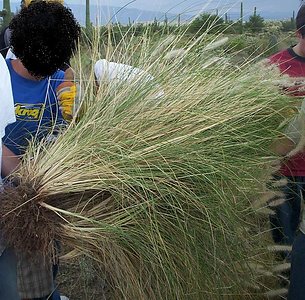Introduction:
When I was pondering what to research for this treehouse, I decided that I wanted to look into an invasive species. Our science class created a 3-D map of Pima County and on it were two prominent invasive species, one being buffelgrass, and the other, bullfrogs. This sparked my interest in invasive species, and when I heard of an optional buffelgrass pull that was going to take place in Sabino Canyon, I instantly signed up (see image at page bottom). During the pull and during my research I learned about the the impact that buffelgrass has on the environment, and once I felt I had done something to help the problem, I thought it necessary to go into more depth and create this page.
Main Content:
An invasive species isn't naturally occuring and its introduction is likely to harm species surrounding it including plants, animals, and people. The effects of invasive species can can be so monumental they can in fact destroy entire ecosystems. With the absence of the native plants, the animals that at one point ate the native plants no longer have a source of food. Invasive plant species generally have no natural predators, so they may stay in existence for a long period of time. Invasive plant species can dry out the soil to a point where the native species can no longer live.
Like every invasive species buffelgrass was introduced to southern Arizona, because invasive species must be artificially introduced to ecosystems. In the 1940s, buffelgrass was brought to Texas from South Africa and India as a foraging grass for cattle. Buffelgrass is now the most popular grass in Texas due to its very high tolerence for drought.
While it is an invasive species, buffelgrass does have a few positive qualities. It can be used as a pastureland plant for all grazing animals, and can be used for the production of hay. If not being looked at as a nuisence, buffelgrass has high drought tolerance, so when water is scarce, buffelgrass is still available for animals to eat. In a highly condensed patch of buffelgrass, the intricacy of its roots can help prevent soil erosion. Another effect than can be looked at both postively and negatively is that buffelgrass can easily adapt to many different types of soils.
Despite these positive qualities, Buffelgrass pushes native grasses and plants out of their habitat. It competes with natural plants for ground surface, sunlight, moisture, and nutrients. Animals that feed on the native plants begin to eat buffelgrass intead, which doesn't have the same nutrients that the native grasses have. Due to its high tolerance to drought, buffelgrass is very difficult to eradicate. In relation to its high drought tolerance, it can very easily adapt to almost any type of soil, including the caliche found in the Sonoran Desert . A final negative effect that buffelgrass has on the ecosystems that it inhabits is that it acts as a fuel for wildfires, due to its extreme dryness. As a result of the wildfires, many native plants are destroyed.
Conclusion
The people that live in communities where buffelgrass is common are well aware of the negative effects of buffelgrass and have spent long hours in effort to eradicate it. However, the only real way to get rid of and prevent the spread of buffelgrass is to pull it out by hand (shown above). The buffelgrass plant must be dug our completely from the roots of the plant, becuase if it were to be just cut down, the seed would still be able to spread to another place and germinate in a different area.






 Go to quick links
Go to quick search
Go to navigation for this section of the ToL site
Go to detailed links for the ToL site
Go to quick links
Go to quick search
Go to navigation for this section of the ToL site
Go to detailed links for the ToL site